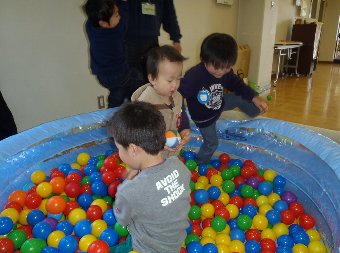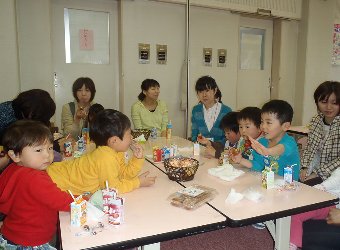East Japan Great Earthquake:Fushima Sou-Sou project Report No.4
In this article, report by a Clinical Psychologist participating this MdM’s project to the Fukushima Sou-Sou area (Minami Souma city, Souma city and Shinchi-mach)
The “Nagomi Mental Health Center for the Soma Greater Area” cooperates in activities twice a month. One of these, the “short break get-together” “Let’s have a little break here” on Saturdays at the Soma-shi Health Center, is designed to give area residents who tend to stay stuck at home an opportunity to get out of the house and discuss their worries and feelings.

“Let’s have a little break here” allows people to consult each other on topics they wish to, and children can also play as there are nursery school teachers to look after them. I participate once a month and so am able to meet with parents and children who come regularly. Children who once were reluctant to separate from their mothers are now able to easily do so, playing with other children. I have been pleased to be able to see this development in front of me.
Activities last for around 2 hours in the morning, and different programs, such as snack time, stretching time, and picture book reading time are selected flexibly. Handicraft making is also done depending on the season, and the staff makes sure to finish the items to a certain point to make them easy for the children and allow them to create items that they can take home with them in a short time.
These activities which I myself have participated in are very fun, but there is something I feel while playing with others.
There is something called a ball pool, a children’s pool where a lot of balls have been placed inside for them to play with. Both children and adults have fun here, mixing the balls and pretending to swim. If this was before the disaster of March 11th, I might shake the pool or make the balls into a wave, saying “it’s a wave! It’s a wave!”to the children. The children like being shaked and such. However, I can’t do that anymore.
There are some things that concern me too much when I play like this. This is because I worry that I might accidentally say “It’s a wave! It’s a wave!” to the children. I wonder why I am concerned so much by this. It might be because, although I am playing with the kids, I have not directly asked them about their experience with the earthquake.
An earthquake occurred during these activities. It was only magnitude 3, but the sideways swaying causes a loud noise which scared me. The area was fairly calm, and people said that “after experiencing March 11th, this is nothing”. After the earthquake calmed down, a person gave me advice on what to be careful of if an earthquake occurs in the Kanto region. This person completely lost their home in the disaster, but still cared about the volunteers. Not just this person, but as I realized through the activities, there are many people who can care for others even when they are in a difficult situation.
I want to know what is at the root of such feelings. While pondering this, a child suddenly said “Hurray! Hurray!” He was a little ways away from me, so I didn’t understand why he said this right away, but I guessed that he was practicing for the exercise field day without paying attention to the earthquake. However, when the child realized the earthquake, the child apparently said “I’m scared”, and then it seems immediately said “That’s right! “Hurray! Hurray!”A staff member said that this was what the child said to himself “in order to defeat his own fear of earthquakes”, and I realized that even children have their own ways of dealing with earthquakes. Oddly, I can still here these words, “Hurray! Hurray!”even today. Through the activities, I understood little by little the children’s memories of their earthquake experience, and I hope to use this knowledge to continue support in the future.
Ayako Sato, Clinical Psychologist
